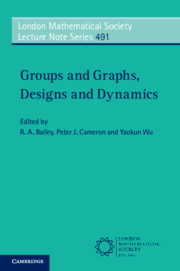1054 results
Linking Digital Traits from Facial Expression, Voice, and Head Motion to Montgomery–Åsberg Depression Rating Scale Subscales
-
- Journal:
- European Psychiatry / Volume 67 / Issue S1 / April 2024
- Published online by Cambridge University Press:
- 27 August 2024, p. S275
-
- Article
-
- You have access
- Open access
- Export citation
Preface
-
- Book:
- Groups and Graphs, Designs and Dynamics
- Published online:
- 11 May 2024
- Print publication:
- 30 May 2024, pp xiii-xvi
-
- Chapter
- Export citation
Contents
-
- Book:
- Groups and Graphs, Designs and Dynamics
- Published online:
- 11 May 2024
- Print publication:
- 30 May 2024, pp v-x
-
- Chapter
- Export citation
Frontmatter
-
- Book:
- Groups and Graphs, Designs and Dynamics
- Published online:
- 11 May 2024
- Print publication:
- 30 May 2024, pp i-iv
-
- Chapter
- Export citation
Author Index
-
- Book:
- Groups and Graphs, Designs and Dynamics
- Published online:
- 11 May 2024
- Print publication:
- 30 May 2024, pp 423-426
-
- Chapter
- Export citation
Authors
-
- Book:
- Groups and Graphs, Designs and Dynamics
- Published online:
- 11 May 2024
- Print publication:
- 30 May 2024, pp xi-xii
-
- Chapter
- Export citation
Subject Index
-
- Book:
- Groups and Graphs, Designs and Dynamics
- Published online:
- 11 May 2024
- Print publication:
- 30 May 2024, pp 427-434
-
- Chapter
- Export citation

Groups and Graphs, Designs and Dynamics
-
- Published online:
- 11 May 2024
- Print publication:
- 30 May 2024
A molecular perspective on the genera Paragonimus Braun, Euparagonimus Chen and Pagumogonimus Chen
-
- Journal:
- Journal of Helminthology / Volume 73 / Issue 4 / April 1999
- Published online by Cambridge University Press:
- 11 April 2024, pp. 295-299
-
- Article
- Export citation
Comparative epidemiology of outbreaks caused by SARS-CoV-2 Delta and Omicron variants in China
-
- Journal:
- Epidemiology & Infection / Volume 152 / 2024
- Published online by Cambridge University Press:
- 19 March 2024, e43
-
- Article
-
- You have access
- Open access
- HTML
- Export citation
Recognizing two dialects in one written form: A Stroop study
-
- Journal:
- Bilingualism: Language and Cognition , First View
- Published online by Cambridge University Press:
- 18 March 2024, pp. 1-17
-
- Article
- Export citation
Effectiveness of a WHO self-help psychological intervention to alleviate stress among healthcare workers in the context of COVID-19 in China: a randomised controlled trial
-
- Journal:
- Epidemiology and Psychiatric Sciences / Volume 33 / 2024
- Published online by Cambridge University Press:
- 07 March 2024, e11
-
- Article
-
- You have access
- Open access
- HTML
- Export citation
Impact of Different Asbestos Species and Other Mineral Particles on Pulmonary Pathogenesis
-
- Journal:
- Clays and Clay Minerals / Volume 47 / Issue 6 / December 1999
- Published online by Cambridge University Press:
- 28 February 2024, pp. 697-707
-
- Article
- Export citation
53 2-Back Performance Does Not Differ Between Cognitive Training Groups in Older Adults Without Dementia
-
- Journal:
- Journal of the International Neuropsychological Society / Volume 29 / Issue s1 / November 2023
- Published online by Cambridge University Press:
- 21 December 2023, pp. 360-361
-
- Article
-
- You have access
- Export citation
78 Remotely monitored in-home IADLs can discriminate between normal cognition and mild cognitive impairment
-
- Journal:
- Journal of the International Neuropsychological Society / Volume 29 / Issue s1 / November 2023
- Published online by Cambridge University Press:
- 21 December 2023, pp. 381-382
-
- Article
-
- You have access
- Export citation
2 Higher White Matter Hyperintensity Load Adversely Affects Pre-Post Proximal Cognitive Training Performance in Healthy Older Adults
-
- Journal:
- Journal of the International Neuropsychological Society / Volume 29 / Issue s1 / November 2023
- Published online by Cambridge University Press:
- 21 December 2023, pp. 671-672
-
- Article
-
- You have access
- Export citation
1 Task-Based Functional Connectivity and Network Segregation of the Useful Field of View (UFOV) fMRI task
-
- Journal:
- Journal of the International Neuropsychological Society / Volume 29 / Issue s1 / November 2023
- Published online by Cambridge University Press:
- 21 December 2023, pp. 606-607
-
- Article
-
- You have access
- Export citation
78 BVMT-R Learning Ratio Moderates Cognitive Training Gains in Useful Field of View Task in Healthy Older Adults
-
- Journal:
- Journal of the International Neuropsychological Society / Volume 29 / Issue s1 / November 2023
- Published online by Cambridge University Press:
- 21 December 2023, pp. 180-181
-
- Article
-
- You have access
- Export citation
59 The Impact of Anxiety on Memory Performance in Older Adults with Depression
-
- Journal:
- Journal of the International Neuropsychological Society / Volume 29 / Issue s1 / November 2023
- Published online by Cambridge University Press:
- 21 December 2023, pp. 844-845
-
- Article
-
- You have access
- Export citation
6 Adjunctive Transcranial Direct Current Stimulation and Cognitive Training Alters Default Mode and Frontoparietal Control Network Connectivity in Older Adults
-
- Journal:
- Journal of the International Neuropsychological Society / Volume 29 / Issue s1 / November 2023
- Published online by Cambridge University Press:
- 21 December 2023, pp. 675-676
-
- Article
-
- You have access
- Export citation





